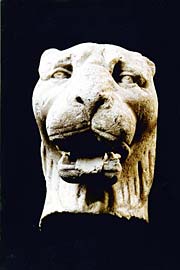Who were the residents of the magnificent Herodian palace in Ramat Handiv that was abandoned during the Great Rebellion?
Ran Shapira

Photo: Zeev Radovan
Dozens of coins of the 66th Roman legion, found during the last excavation seasons in the Herodian palace in Ramat Handiv, testify to the end of the magnificent structure. Prof. Yizhar Hirschfeld, an archaeologist from the Hebrew University who has been leading the excavations at the site since the XNUMXs, says that it is possible to learn from them that the palace was abandoned during the Great Revolt, which began in XNUMX AD not far away - in Caesarea.
The findings do not make it possible to determine whether the palace was conquered by force or was abandoned and fell into the hands of the Romans, says Hirschfeld. But they teach about the panic with which its inhabitants left it. Among other things, a gold earring and a gold purchase pin were discovered on the site - jewelry that even a man of means does not leave behind when he moves away from his place of residence.
The jewels are added to many other finds, which testify to the wealth of the person who built the palace and his senior status during the reign of Herod, who reigned in Judea in the years 4-37 BC. First and foremost, this is evidenced by the dimensions of the palace. It covered an area of 6,000 square meters and contained about a hundred rooms, many of which were well preserved. A wall was built around the palace, which is two meters thick and large guard towers were placed at its four corners.
The walls of the rooms were lined with marble imported from Italy and in many of them pottery was found, which were also made in Italy and were considered prestigious and high quality. A marble panther's head is found in the palace garden. The researchers believe that the head was used as a table leg. Round marble tables with three legs were found in Pompeii, which were also shaped like a panther's head - the animal that symbolizes Dionysus, the god of wine.
At the foot of the hill at the top of the palace springs a spring, next to which a Roman bathhouse was built with all its details and grammar and a swimming pool, where the residents could refresh themselves on hot summer days. To the bath house and the pool went down a flight of stairs, built down the hill.
The water from the spring was used for purification, so no mikveh was built in the palace, says Hirschfeld, but there are other signs that show that the palace's occupants (whoever built it and his successors, who were forced to abandon it) were Jews. One of the most striking signs is the many stone tools left in the palace. At the time it was built, at the end of the Second Temple period, it was accepted that stone vessels do not receive impurity and therefore they were used in Jewish settlements.
Another sign is clay candles, called scrubbed candles. These candles, which were accepted among Jews, were made of stones and their heads were cut with a knife. Their production center was in Jerusalem and their presence in the palace at Ramat Handiv is another sign of the good relations of the owner of the house with the central city of the government.
The identity of the homeowner remains unknown. So far, no inscription has been found in the palace from which it is possible to learn who built the palace and who were his heirs, and the main source of information about the period - Joseph ben Matthew's book "The Antiquities of the Jews" - does not mention them either. However, it is clear that like all the senior officials at the end of the Second House period, their fate did not improve upon the outbreak of the Great Rebellion and they were forced to abandon their home.
